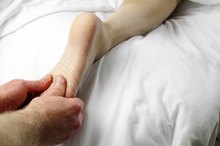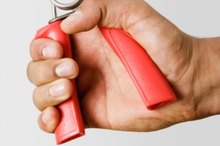Exercises That Reduce Ankle Swelling
Swollen ankles are caused by fluid building up around the foot and ankle. Common causes of ankle swelling include injury, age, pregnancy, extended standing and long drives or flights. Exercising the swollen ankles can help pump the excess fluid out and reduce the swelling.
Isometric Up and Down
Isometric ankle exercises are designed to get the blood flowing, restore range of motion and reduce swelling in the ankle. Avoid side-to-side turning if you still have pain from spraining your ankle. Start by sitting on the floor or in a chair so that you can extend your leg straight out. Alternate pointing your ankle as far up and as far down as you can, holding each extreme position for one second and repeat each direction at least 15 times.
- Isometric ankle exercises are designed to get the blood flowing, restore range of motion and reduce swelling in the ankle.
- Start by sitting on the floor or in a chair so that you can extend your leg straight out.
Isometric In and Out
How to Strengthen the Patella Tendon
Learn More
The in-and-out drill is another isometric exercise for the ankle. Aavoid this movement until the joint is pain free if you have sprained your ankle. Start in a seated position on the floor or on a chair with your leg extended straight out in front of you. Turn your ankle to each side as far as you can, pointing it in and then out and holding the extreme position for one second on each side. Alternate each direction until you have performed at least 15 repetitions both ways.
- The in-and-out drill is another isometric exercise for the ankle.
- Turn your ankle to each side as far as you can, pointing it in and then out and holding the extreme position for one second on each side.
Balance and Wobble Board Exercises
Balance and wobble board exercises are designed to force the ankle to do more work to support the body, which in turn increases range of motion and reduces fluid build up. Start by standing next to a wall or chair and standing on one leg for 30 seconds while using the chair to help support your balance. A wobble board is a board that is unstable and rotates, forcing your ankles to move to stabilize the board. It is best to use the board sitting until you gain strength and experience with the device. Start by sitting in a chair with your knees bent to a 90-degree angle. Move your feet forward and backward on the board to make the ankle move. As you improve, you can start moving side to side and in circular motions to further increase flexibility.
- Balance and wobble board exercises are designed to force the ankle to do more work to support the body, which in turn increases range of motion and reduces fluid build up.
- Start by standing next to a wall or chair and standing on one leg for 30 seconds while using the chair to help support your balance.
Heel and Toe Raises
Physical Therapy Exercises for a Hyperextended Toe
Learn More
Heel and toe raises are calf exercises, but because they require the ankle to move, they can help get rid of swelling in the ankle area. Start with seated movements and progress to standing raises as you get stronger. For heel raises, simply sit with your knees at a 90-degree angle and your feet flat on the floor. Raise your heels off the ground as high as you can and hold the peak position for two seconds before returning to the starting position to complete one repetition. To perform toe raises, start in the same position and raise your toes off the floor as high as you can like you are trying to touch your toes to your calves. Hold the high position for two seconds and return to the starting position to complete one repetition.
- Heel and toe raises are calf exercises, but because they require the ankle to move, they can help get rid of swelling in the ankle area.
- To perform toe raises, start in the same position and raise your toes off the floor as high as you can like you are trying to touch your toes to your calves.
Related Articles
References
- University of Maryland Medical Center: Foot, Leg and Ankle Swelling
- Beckenkamp PR, Lin CC, Herbert RD, et al. EXACT: exercise or advice after ankle fracture. Design of a randomised controlled trial. BMC Musculoskelet Disord. 2011;12:148. doi:10.1186/1471-2474-12-148
- Habets B, van Cingel REH, Backx FJG, Huisstede BMA. Alfredson versus Silbernagel exercise therapy in chronic midportion Achilles tendinopathy: study protocol for a randomized controlled trial. BMC Musculoskelet Disord. 2017;18(1):296. doi:10.1186/s12891-017-1656-4
Writer Bio
Based in Harker Heights, Texas, Timothy Onkst has been writing about sports, fitness and health since 2003. His articles have appeared in a variety of publications including "Texas Roundball" magazine, Yahoo Sports, Fox Sports and other websites.









